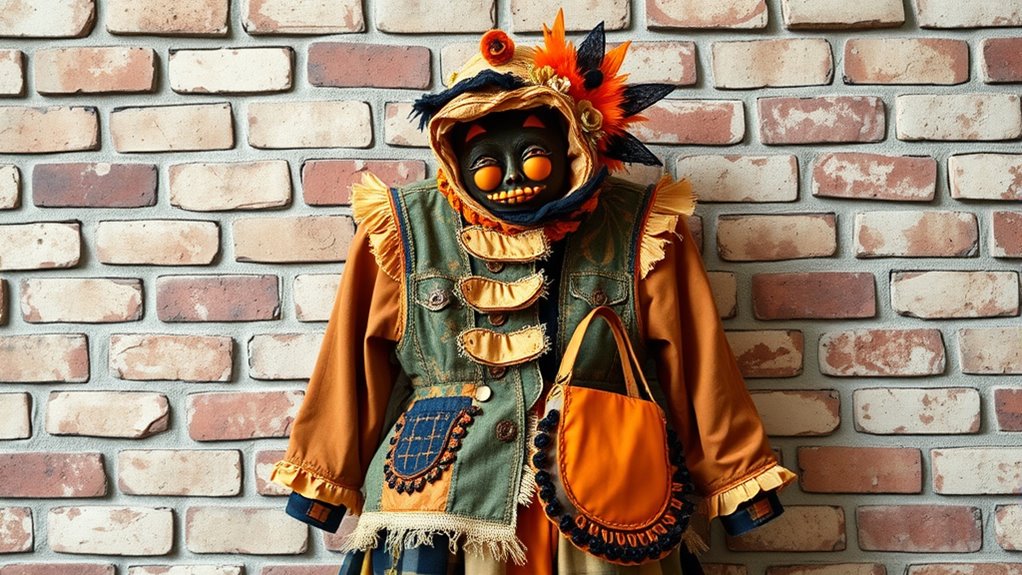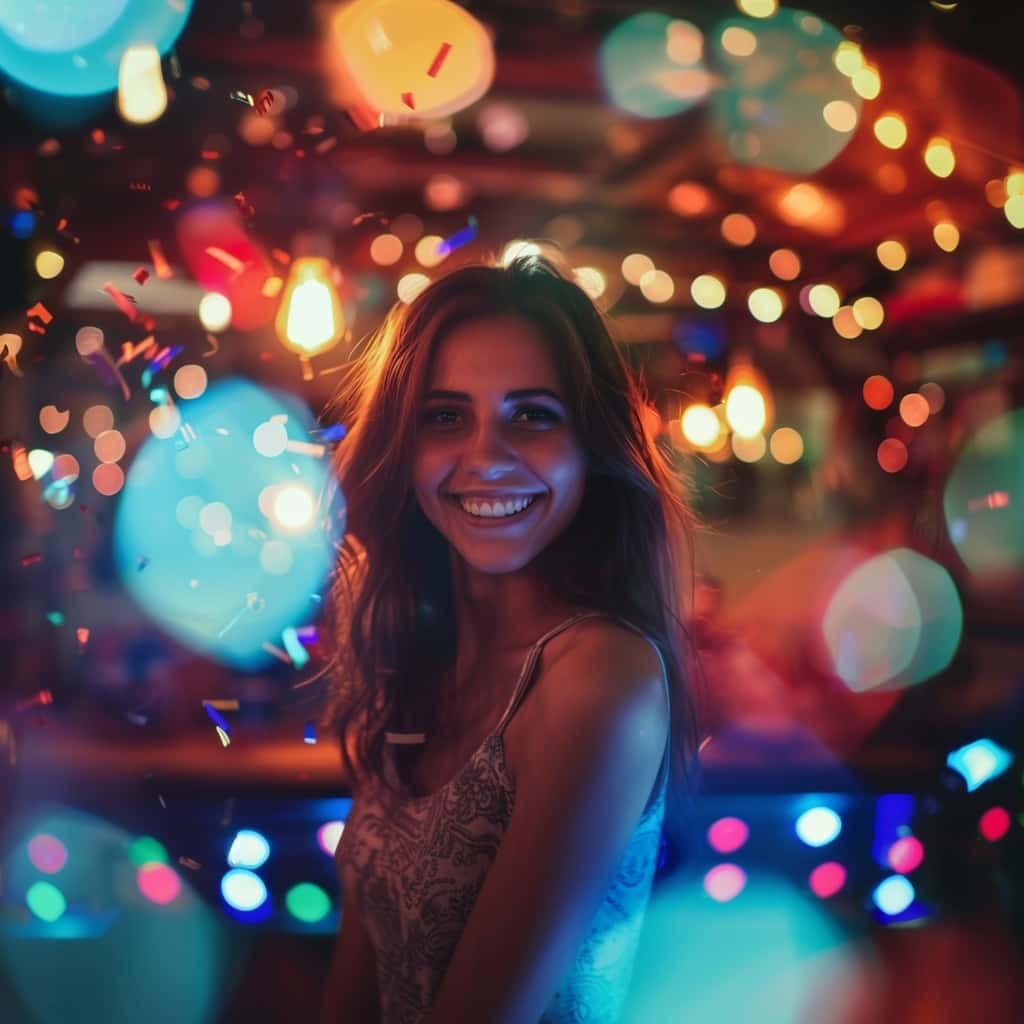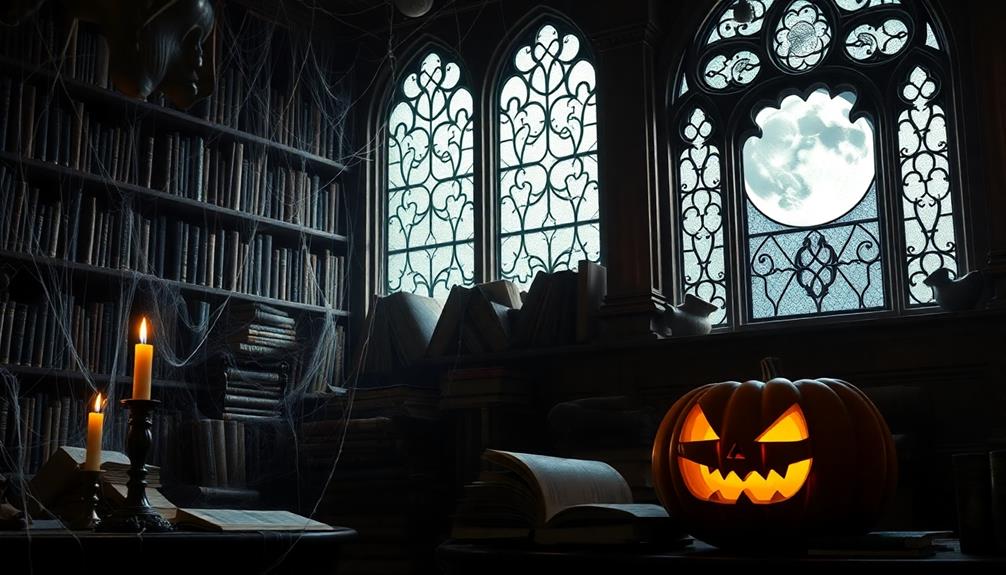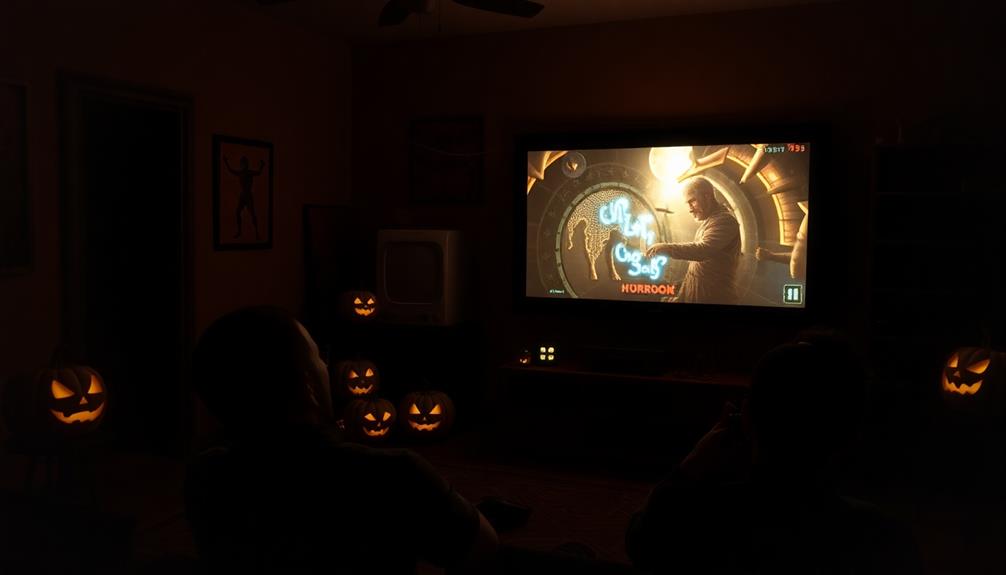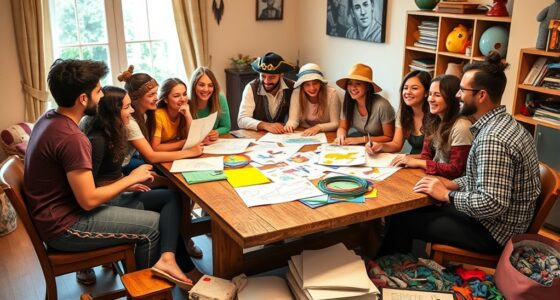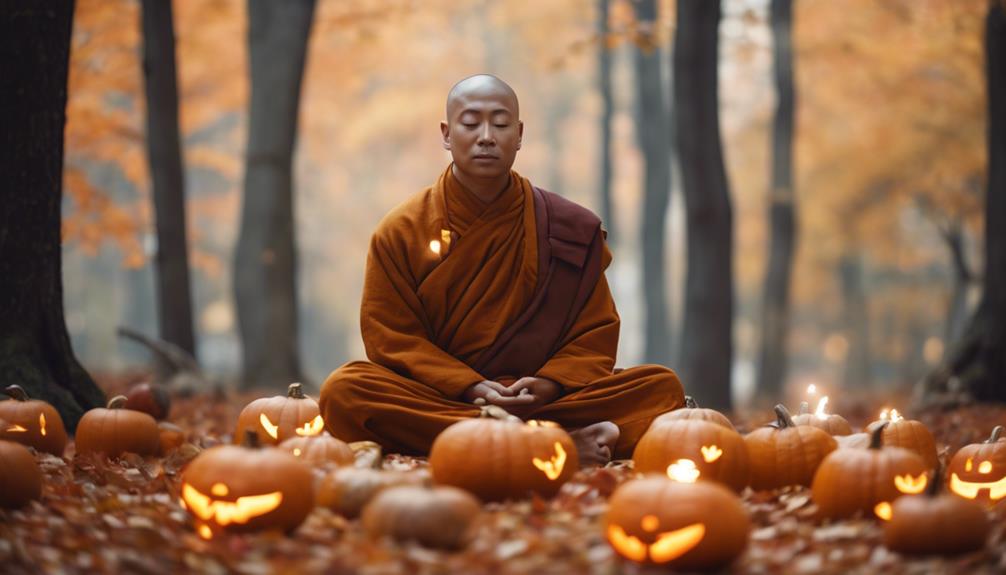If you’re into upcycling for Halloween, thrift-flip costumes let you reuse and customize clothes for eco-friendly, standout looks. Start by finding vintage or unique items at thrift stores, then get creative by cutting, sewing, or painting to transform your pieces. Add fun accessories and details to make your costume shine. Want to discover step-by-step tips and eco-conscious tricks to craft your perfect costume? Keep exploring—there’s more to inspire your creative reuse journey.
Key Takeaways
- Start with thrift store finds, selecting vintage or unique garments suitable for easy upcycling into Halloween costumes.
- Use sewing, cutting, and dyeing techniques to transform thrifted items into creative, eco-friendly costumes.
- Incorporate accessories, props, and fabric details to personalize and enhance the costume’s story and style.
- Share the upcycling process and final look on social media to promote sustainable costume practices.
- Prioritize eco-conscious materials and techniques, emphasizing reuse, recycling, and minimal waste in your costume creation.
Finding Inspiration for Your Upcycled Costume
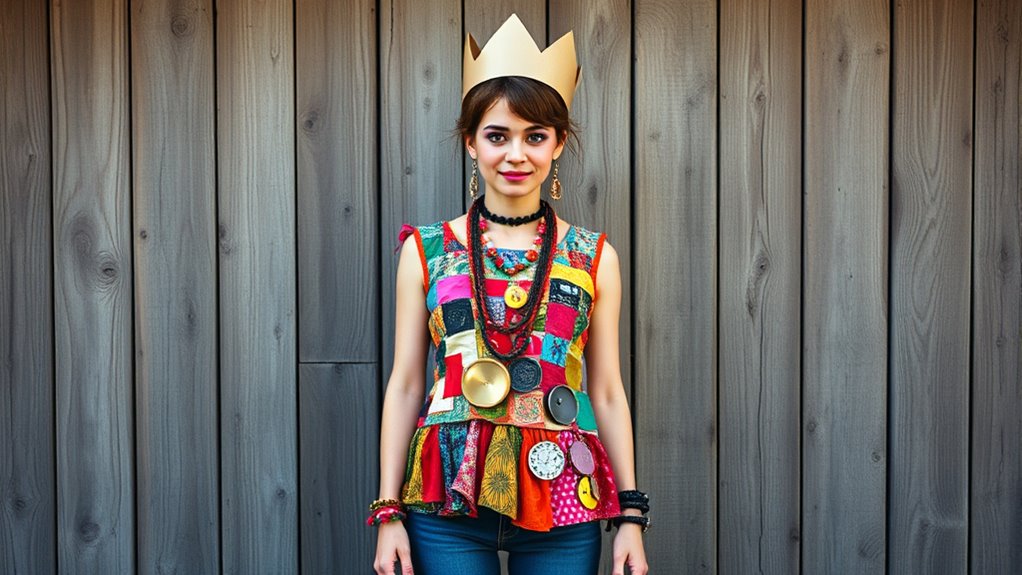
Finding inspiration for your upcycled costume can be both exciting and challenging, but starting with something you love makes the process easier. Look to sustainable fashion trends or your favorite movies, characters, or themes for ideas. Browse online for DIY costume ideas that emphasize creativity and eco-friendliness. Pinterest and social media platforms are great sources for fresh inspiration, showing how others transform thrifted items into stunning outfits. Consider using items you already own or find in thrift stores, then reimagine them in new ways. Think outside the box—mix patterns, repurpose fabrics, or combine unexpected elements. Incorporating upcycling techniques can elevate your costume and make it more environmentally friendly. By focusing on what excites you, you’ll find inspiration that sparks your creativity and helps craft a unique, eco-conscious costume.
Essential Thrift Store Finds for Creative Costumes
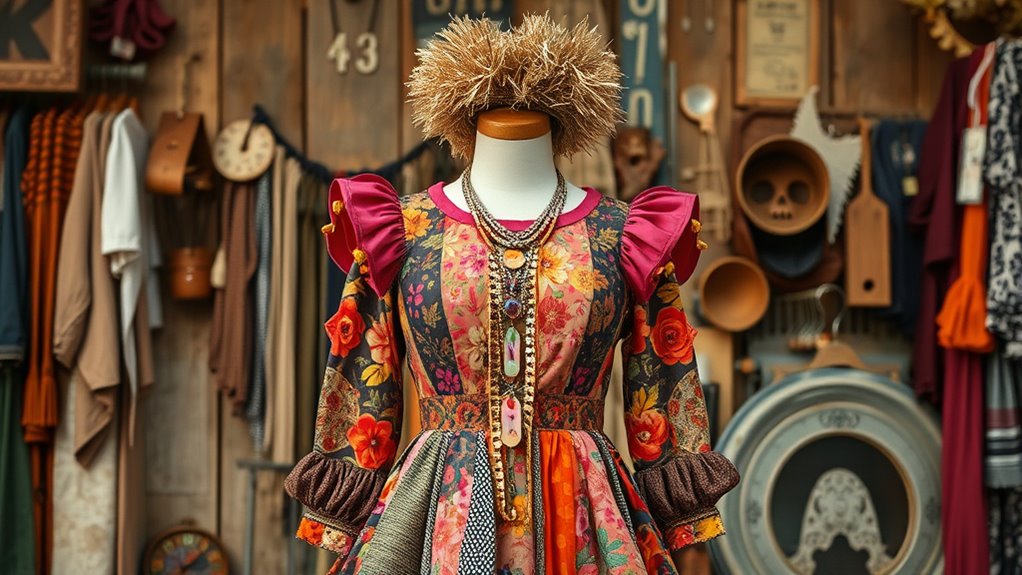
When browsing thrift stores, look for vintage clothing gems that can serve as the foundation of your costume. Don’t forget to pick up unique accessories that can add personality and flair, making your outfit stand out. Keep an eye out for DIY fabric finds, which give you endless options for customizing your look. Additionally, sourcing items with potential for cost savings can help you create impressive costumes without overspending.
Vintage Clothing Gems
Vintage clothing gems are your secret weapons for creating one-of-a-kind costumes that stand out. These pieces offer unique textures, patterns, and styles that can transform a simple idea into an eye-catching outfit. By choosing vintage clothing, you tap into upcycled fashion, giving new life to garments that might otherwise be discarded. Look for standout items like retro dresses, classic jackets, or quirky accessories that can be repurposed or customized. Mixing and matching vintage finds allows you to craft authentic, personalized costumes with character and charm. Plus, vintage clothing often has quality details that modern pieces lack, adding depth to your costume. Embrace these gems for a sustainable, creative approach to Halloween dress-up that’s both stylish and environmentally friendly. Incorporating upcycled fashion into your costume design supports eco-friendly practices and highlights your creativity.
Unique Accessory Options
Unique accessories can take your thrift-flip costumes from good to unforgettable. When accessorizing costumes, look for standout pieces like vintage jewelry, bold hats, or quirky props that tell a story. Thrift stores often have an array of affordable, one-of-a-kind items perfect for adding personality and flair. These accessories not only enhance your costume but also support sustainable fashion by reusing and repurposing items. Consider layering necklaces, pinning on vintage brooches, or adding a unique scarf to create depth and character. Small details like gloves, belts, or costume-specific props can elevate your look effortlessly. By carefully selecting these thrifted accessories, you make your costume memorable while making eco-conscious choices, embodying the spirit of sustainable fashion. Incorporating unique accessories can also help customize your costume to better reflect your personal style.
DIY Fabric Finds
Shopping for DIY fabric finds at thrift stores opens up endless possibilities for creating custom costumes without breaking the bank. Look for versatile fabrics like cotton, polyester, or velvet that can be transformed with fabric dyeing to match your costume’s theme. Don’t hesitate to pick up mismatched or plain fabrics—you can easily elevate them with simple sewing techniques, adding details or combining pieces for unique textures. Consider fabrics with interesting textures or patterns, which can become focal points in your costume. With basic sewing skills, you can create custom accessories or modify thrifted garments. Upcycling fabric is both eco-friendly and budget-friendly, allowing you to craft one-of-a-kind costumes that reflect your creativity and style. Additionally, choosing Gold IRA rules and regulations compliant fabrics ensures your costume projects remain environmentally sustainable and financially savvy.
Step-by-Step Guide to Crafting Your Thrift-Flip Look
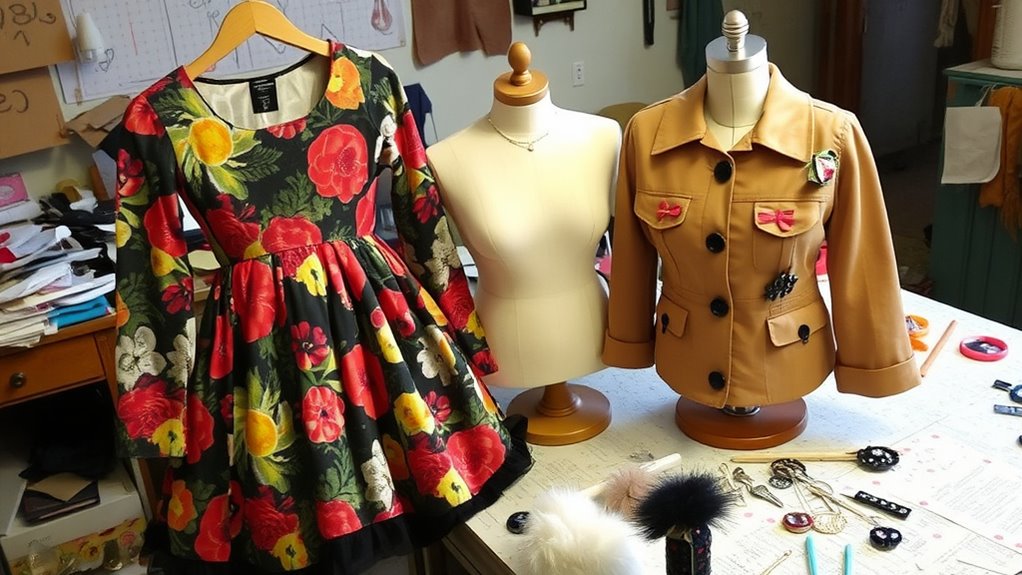
Creating a thrift-flip costume is an exciting process that combines creativity with resourcefulness. First, select a base piece from your thrift store haul, focusing on items that can be easily transformed. Use recycling techniques like cutting, sewing, or painting to modify the garment into your desired costume. Remember, durability matters—choose sturdy fabrics and reinforce seams to guarantee your costume lasts through the night. Next, plan your design and gather any additional materials needed for details or embellishments. Follow a step-by-step approach: prep your materials, make your cuts, sew or glue elements into place, and test for comfort and sturdiness. Incorporating preppy dog names into your costume theme can add a fun, sophisticated touch. With patience and attention to detail, you’ll craft a unique, eco-friendly costume that’s both stylish and durable.
Budget-Friendly Accessories and Final Touches
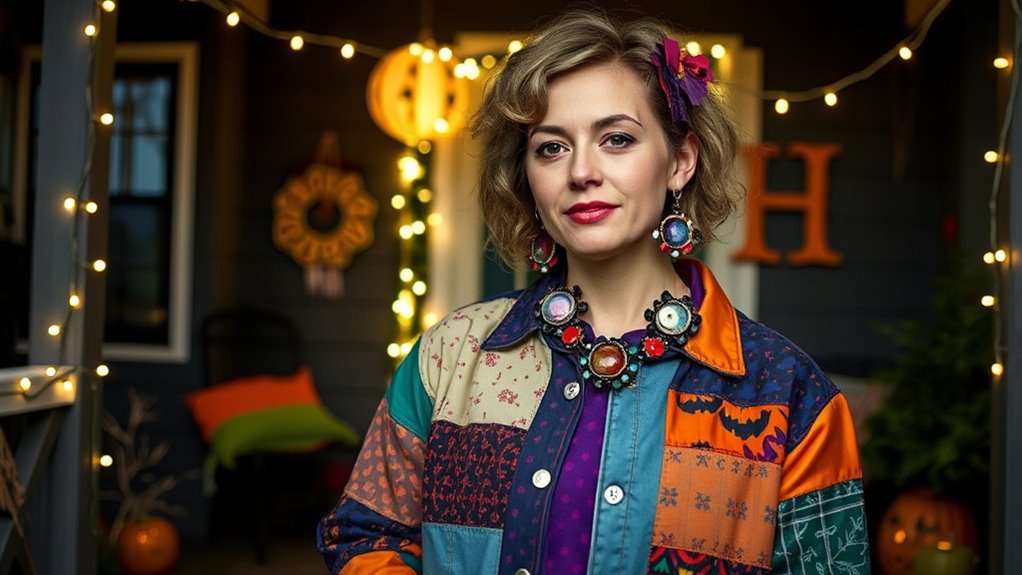
Once your thrift-flip costume is assembled, adding budget-friendly accessories and final touches can really bring your look together without breaking the bank. Use simple accessorizing tips like statement jewelry, scarves, or hats to enhance your costume’s personality. Look for items at thrift stores or dollar stores that complement your theme, avoiding overspending. Focus on costume finishing touches, such as a bold belt, DIY face paint, or themed props, to make your outfit pop. Small details like gloves or costume-specific makeup can elevate your look without much effort or expense. Remember, the key is to keep it fun and creative—sometimes, a few well-chosen accessories can turn a good costume into a memorable one. Additionally, incorporating affordable electric accessories, like battery-powered lights or small gadgets, can add a surprising and modern twist to your costume.
Eco-Conscious Tips to Maximize Your Upcycling Efforts
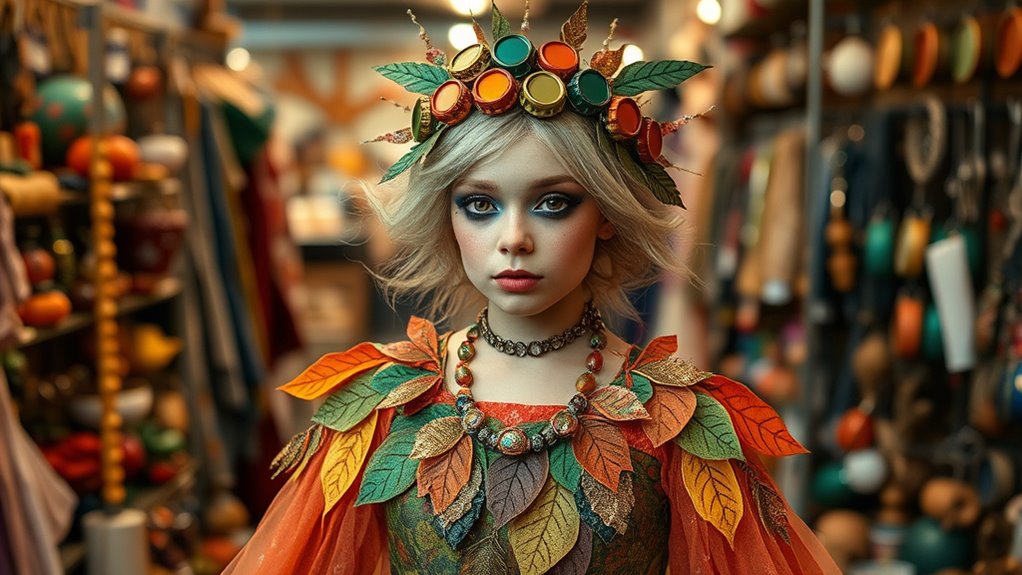
To maximize your upcycling efforts, focus on repurposing items with intention and care. Choose sustainable materials whenever possible, such as organic fabrics or recycled textiles, to reduce environmental impact. When dyeing or customizing your costume, opt for eco-friendly dyes that are less harmful to the planet. These dyes often come in plant-based or low-toxicity options, ensuring your creative process stays eco-conscious. Plan your design carefully to avoid waste, and consider how each piece can serve multiple purposes or be reused in future projects. Incorporating upcycling techniques can elevate your costume and minimize waste. By prioritizing sustainable materials and eco-friendly dyes, you not only craft a unique costume but also contribute to a more sustainable Halloween celebration. Small mindful choices can profoundly amplify your upcycling impact.
Showcasing Your Costume and Sharing Your Creativity

Showcasing your thrift-flip costume is a great way to inspire others and celebrate your creativity. By sharing your process and final look, you promote sustainable fashion and highlight the importance of costume sustainability. You can showcase your costume at parties, on social media, or in community events. To make your presentation stand out, consider creating a brief behind-the-scenes video or a photo collage that details your upcycling journey. Share tips on how you chose materials, the challenges you faced, and how you transformed thrifted items into a unique costume. You might also encourage others to try upcycling themselves. Remember, your creativity not only sparks ideas but also champions eco-friendly practices and the value of giving new life to old items. Exploring personality traits can help you better understand your creative style and how you approach projects like thrift-flip costumes.
Frequently Asked Questions
How Can I Ensure My Thrift-Flip Costume Is Comfortable to Wear All Night?
To guarantee your thrift-flip costume stays comfortable all night, focus on fabric choice and costume fit. Pick soft, breathable fabrics like cotton or jersey, avoiding stiff or scratchy materials. Make sure the costume fits well without being too tight or too loose, allowing easy movement. Try it on beforehand, adjusting straps or seams as needed. By prioritizing comfort and proper fit, you’ll enjoy your Halloween festivities all night long.
What Safety Tips Should I Consider When Crafting Upcycled Costumes?
When crafting upcycled costumes, you should prioritize safety by avoiding fire hazards; use flame-resistant fabrics or keep open flames away. Check for choking hazards, especially with small or loose decorations that could detach. Guarantee all parts are securely attached and avoid sharp edges. Test the costume’s comfort and fit to prevent irritation or tripping. Always supervise children and opt for non-toxic, safe materials to make your costume both fun and safe.
How Do I Choose Sustainable Materials for My Costume Modifications?
You should prioritize fabric selection by choosing natural, organic materials like cotton or hemp, which are more eco-friendly and biodegradable. Investigate the use of eco-friendly dyes, such as plant-based or low-impact options, to reduce chemical runoff. This approach not only makes your costume sustainable but also aligns with eco-conscious values. By researching and selecting these materials carefully, you guarantee your upcycled costume is both creative and environmentally responsible.
Can Thrift-Flip Costumes Be Suitable for Themed or Formal Halloween Parties?
Yes, thrift-flip costumes can be perfect for themed or formal Halloween parties. You can customize thrifted items to match specific themes or elevate them with elegant accessories for formal looks. Focus on selecting versatile pieces and adding unique details to create a cohesive, stylish costume. Upcycling allows you to craft one-of-a-kind outfits that stand out at any themed or formal event, showcasing your creativity and commitment to sustainability.
What Are Some Common Mistakes to Avoid When Upcycling for Costumes?
You don’t want your costume to fall apart faster than a house of cards, so avoid common mistakes like poor fabric selection and neglecting size adjustments. Choose durable fabrics that match your costume’s theme, and always try on pieces for proper fit before sewing. Don’t rush the process—taking your time guarantees your upcycled creation looks fabulous and stays intact throughout the night. Be mindful, and your costume will shine!
Conclusion
By upcycling thrift store finds for Halloween, you not only craft unique costumes but also reduce waste—did you know that Halloween costumes generate over 2,000 tons of waste annually? Embracing thrift-flip costumes lets you save money and help the environment. So, get creative, think outside the box, and show off your eco-friendly masterpiece. Your one-of-a-kind look will stand out while making a positive impact—happy upcycling!
